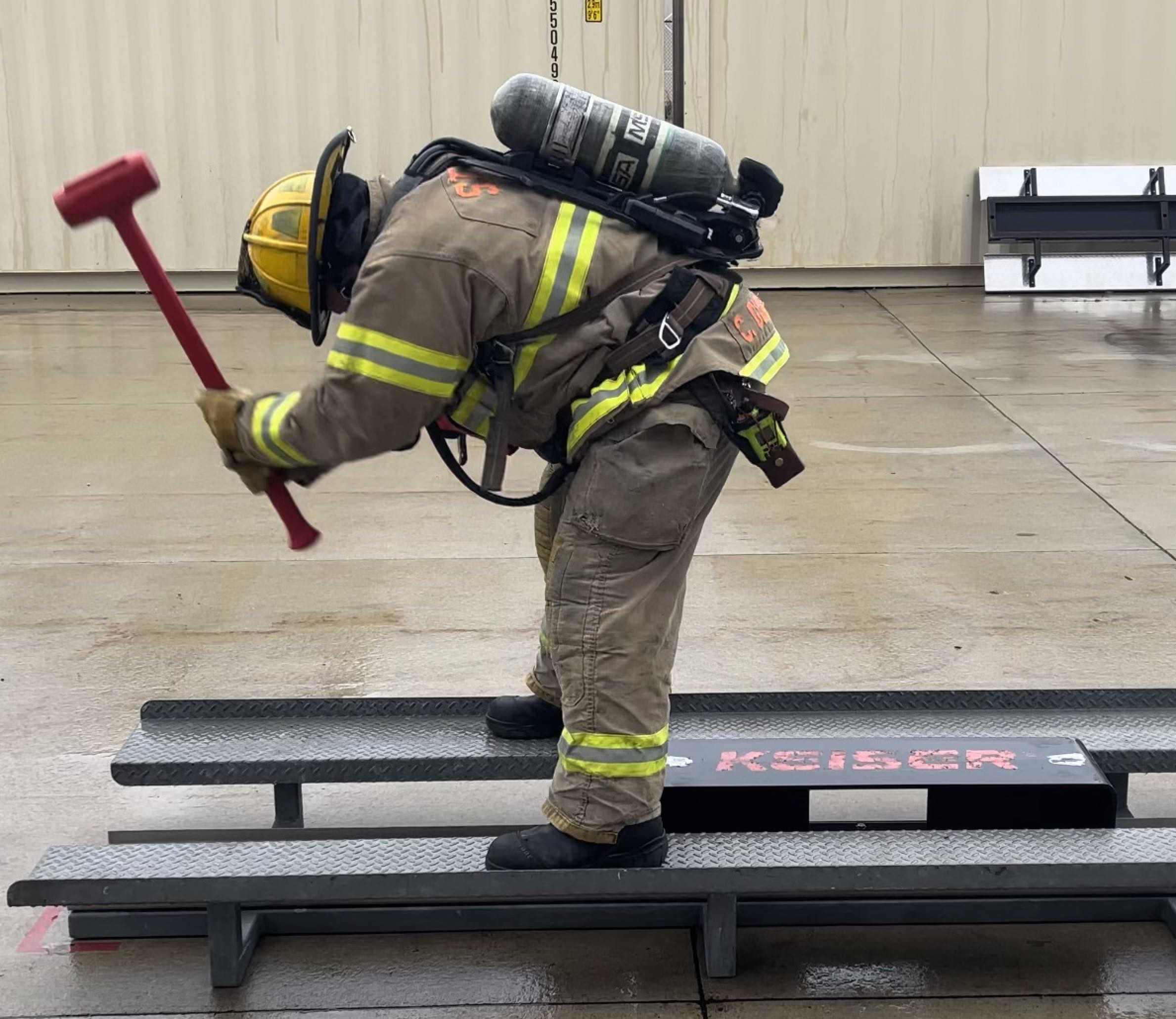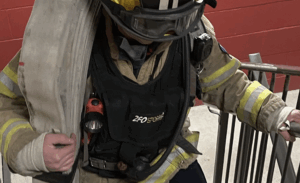Why is this article important?
In the world of aspiring firefighters, conquering the rigorous physical ability tests is a crucial step toward realizing their career dreams. This article delves into the realm of firefighter physical ability tests, shedding light on the two prominent assessments: the Candidate Physical Ability Test (CPAT) and the Timed Physical Ability Test (T-PAT).
- Grasping distinctions between CPAT and timed tests lets candidates tailor their training, addressing the unique challenges and skills of each.
- Knowing both test types cultivates versatility—candidates build strength, endurance, and technique for timed tests and skills for CPAT’s task-based scenarios, enhancing success odds across firefighter selection processes.
By grasping the type of test you’ll face and comprehending its components, you empower yourself to navigate the preparation process precisely, increasing your chances of excelling in the firefighter physical ability test.
Table of Contents
Learn How You Can Become A Firefighter
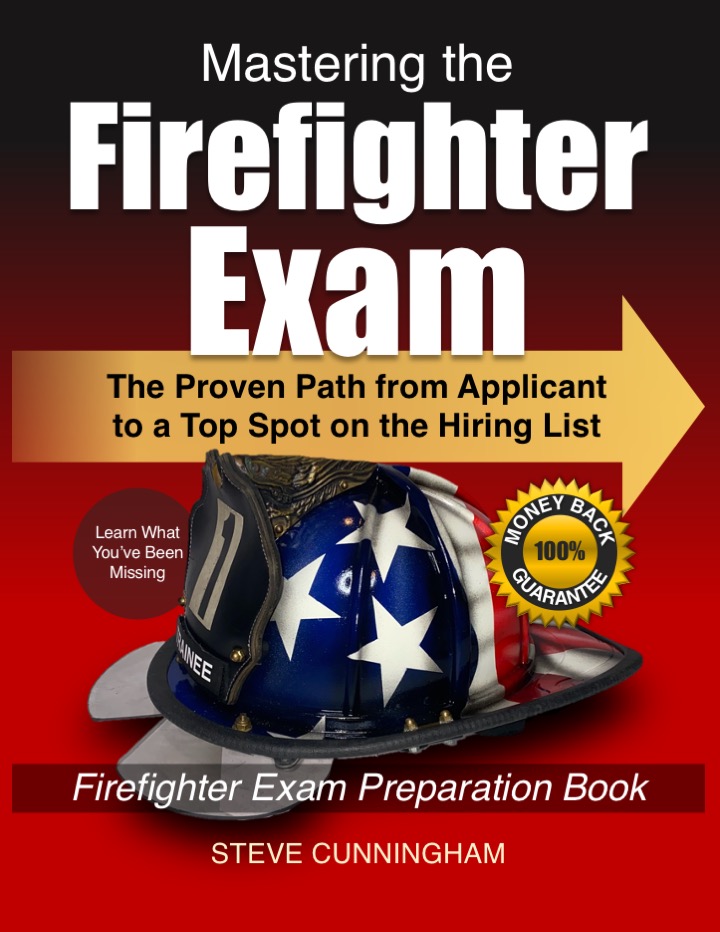
Mastering the Firefighter Exam is a complete guide on how to pass the firefighter exam with a top score. It simplifies the complicated hiring practices of big city fire departments and reveals insider information most candidates don’t know about.
If You Would Like To Know How To Get A Head Of Your Competition, This Book Is For You.
The Firefighter Physical Ability Test
Being a career firefighter is one of the most physically demanding jobs a person can have. As a result, it’s no surprise that the Physical Ability Test (PAT) is a critical part of the firefighter assessment process.
The PAT is a tool the fire department uses to qualify a candidate for a job as a firefighter. Every hiring authority across the country requires a firefighter physical ability test that reflects the situations a firefighter is likely to encounter.
The personal safety of a fire department’s members – and that of the people they serve – depends on the physical abilities of a department’s members.
PATs are designed to measure a candidate’s muscular strength and cardiovascular endurance. Most PATs include a series of events that resemble the tasks a firefighter might encounter during the job.
There are two types of Firefighter Physical Ability Tests
#1 The Timed Physical Ability Test (T-PAT)
#2 The Candidate Physical Ability Test (CPAT)
What’s the difference?
The main differences between the T-PAT (Timed Physical Ability Test), which is department-specific and the CPAT (Candidate Physical Ability Test), which is a standardized national test are as follows:
Timed Firefighter Physical Ability Test (T-PAT):
- Organized by specific fire departments for hiring.
- Varies in test components depending on the department.
- Scores are based on timed completion of tasks.
- Refrain from providing a national certification.
Candidate Physical Ability Test (CPAT):
- A standardized, national test.
- Consists of eight standardized components.
- Candidates either pass or fail.
- Provides a nationally recognized certification.
- Candidates must hold certification at the time of hiring.
While both assess physical abilities for firefighting, the CPAT offers a consistent, nationally recognized certification. In contrast, department-specific tests are tailored to individual departments and are not nationally recognized.
Find out which firefighter physical ability test you’ll be taking during the open application.
During the open application period, instructional packets describing details on the physical ability test are usually made available to candidates. Some departments offer orientations, fitness training plans, and even practice sessions.
You don’t want to wait.
Contact the city’s Department of Human Resources for specifics on the test type, date, and any opportunities offered before the test. Then, mark your calendar with the test date and ramp up training to peak the test week.
#1. The Timed-Physical Ability Test (T-PAT)
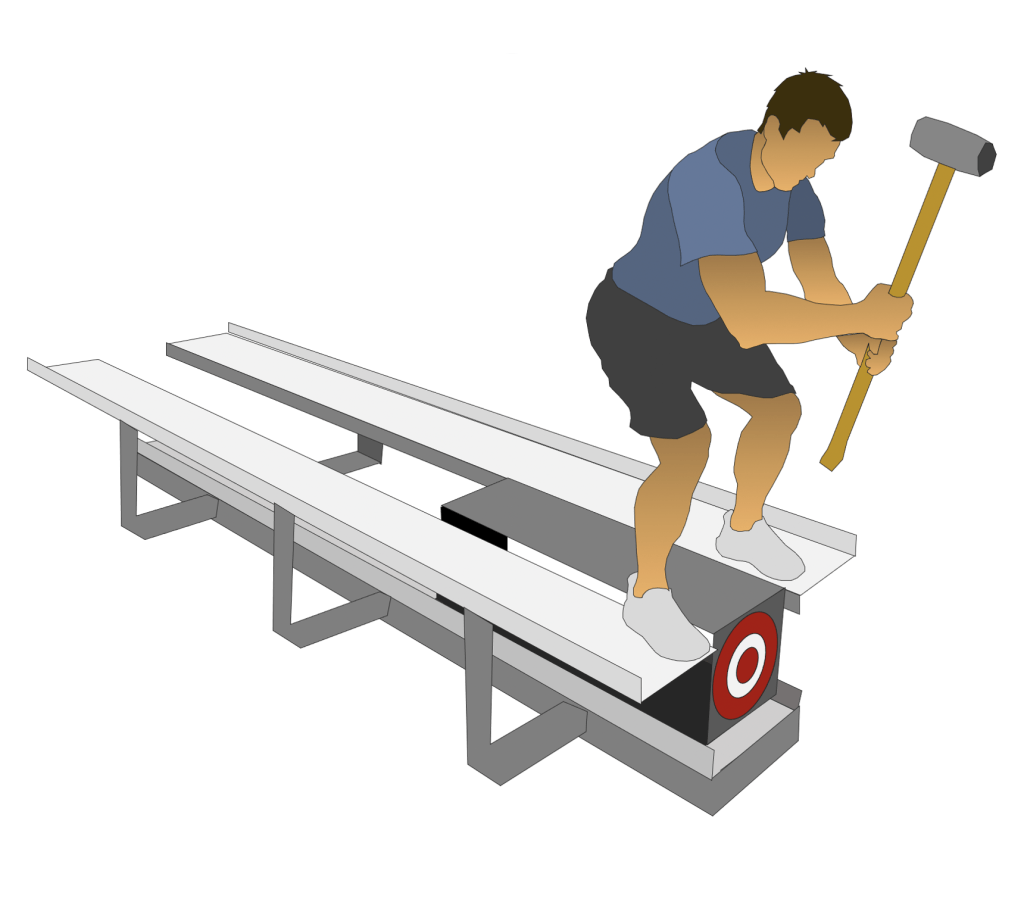
The Timed Physical Ability Test for firefighters is a rigorous assessment that mirrors the intensity of real firefighting scenarios. This dynamic challenge evaluates participants’ physical and mental prowess through demanding tasks. These tasks encompass a range of skills, including strength, agility, and strategic thinking, as participants navigate obstacles as firefighters strive to achieve their best times.
Competitive Testing Process
The T-PAT is a competitive test that resembles the Firefighter Combat Challenge – a national sporting event in which firefighters from the U.S. and the world compete in various fitness events. It’s a demanding five or six-event course in which firefighters compete for the fastest time.
Some fire departments use segments like this competition as a roadmap for their physical ability test because they mimic real-life firefighter scenarios.
Most do not use every component of every event. Instead, they modify events to reflect the needs and values of their unique situation. There will be variations between T-PAT tests from department to department, but all focus on fire scene job-related skills.
Several times, candidates have challenged the legitimacy of the competitive T-PAT format for physical ability tests in the courts. Still, the test has held up to scrutiny and litigation. (The candidates did not win their cases.)
Sequence of Events
This test is typically a sequence of events that requires the candidate to progress along a predetermined path from event to event continuously. Departments will choose different events or change the sequence of events. (There is not a standard version of the T-PAT.)
Common Timed Physical Ability Tests (T-PAT) events
While the specifics may vary, the test typically includes a range of tasks designed to mimic real-life firefighting scenarios. Some of the tasks that could be part of the challenge include:
- Stair Climb: Climb six flights of stairs, with a weighted vest and SCBA, while carrying a hose bundle, emulating the urgency of navigating a fire scene.
- Hose Hoist: Swiftly hoisting a hose roll to the sixth floor of an elevated platform, demonstrating upper body strength and coordination.
- Hose Drag: Drag a charged hose line 100’.
- Equipment Carry: Walk 75’ carrying equipment (typically either two saws or one box fan)
- Forcible Entry: Use a 10 lb. sledgehammer to advance a weighted sled prop (Keiser Sled) to simulate forcible entry.
- Rescue: Lift and drag a 165-pound dummy for 70’.
Common Attire and Challenges
- Candidates may be required to wear approved gear, including long pants, a helmet, eye protection, firefighter work gloves, and proper footwear.
- Candidates usually wear a self-contained breathing apparatus (SCBA) or a 50-pound weighted vest to simulate an SCBA.
- Events are placed in a sequence that best simulates fire scene situations while allowing a recovery walk between events.
- No running is allowed between events.
Testing Site and Scoring the T-PAT
Testing Sites
Most T-PATs are administered by the city department of human resources at the fire department’s training center. Some departments offer orientations, fitness training plans, and practice sessions.
Scoring the T-PAT
The hiring authority grades the results from the different candidates and places them on a rank-ordered list. This is a competitive test where the shorter-timed score will rank higher than the longer-timed score.
The results of the written and physical ability tests are averaged and placed on a rank-ordered list with the highest average score at the top.
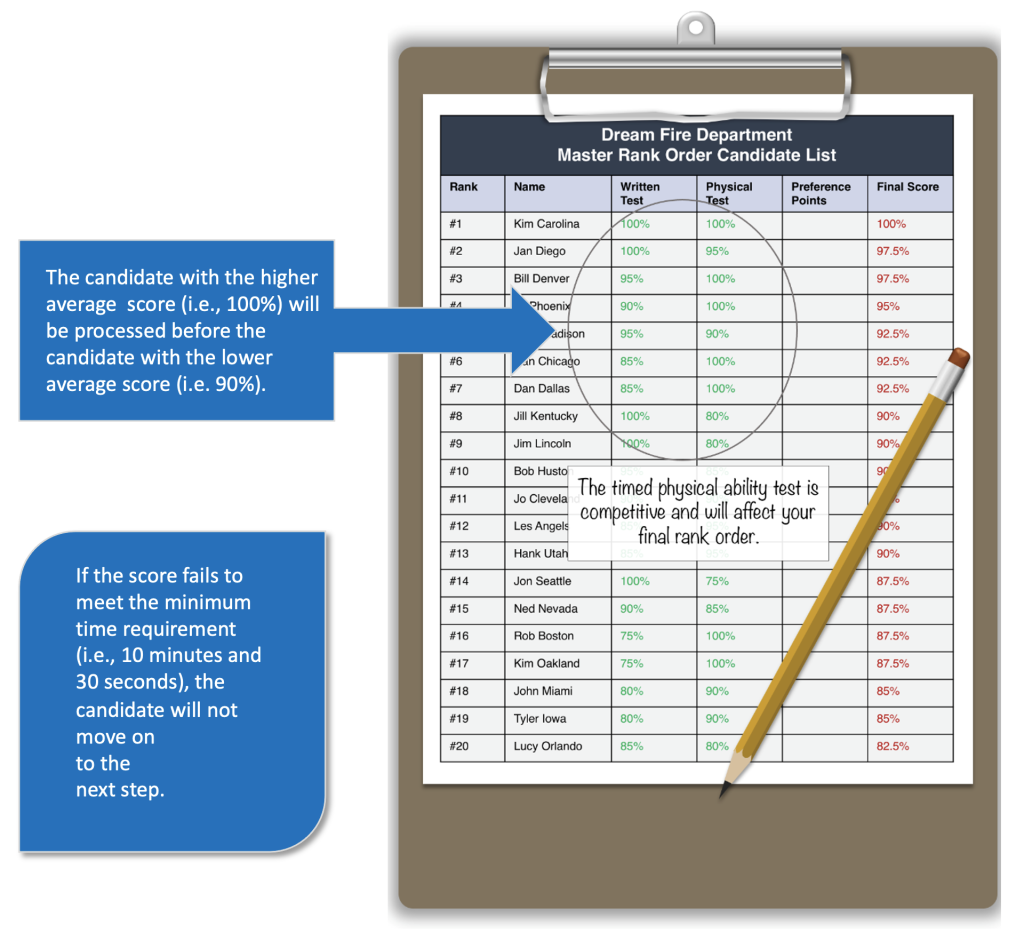
#2. The Firefighter Candidate Physical Ability Test (CPAT)
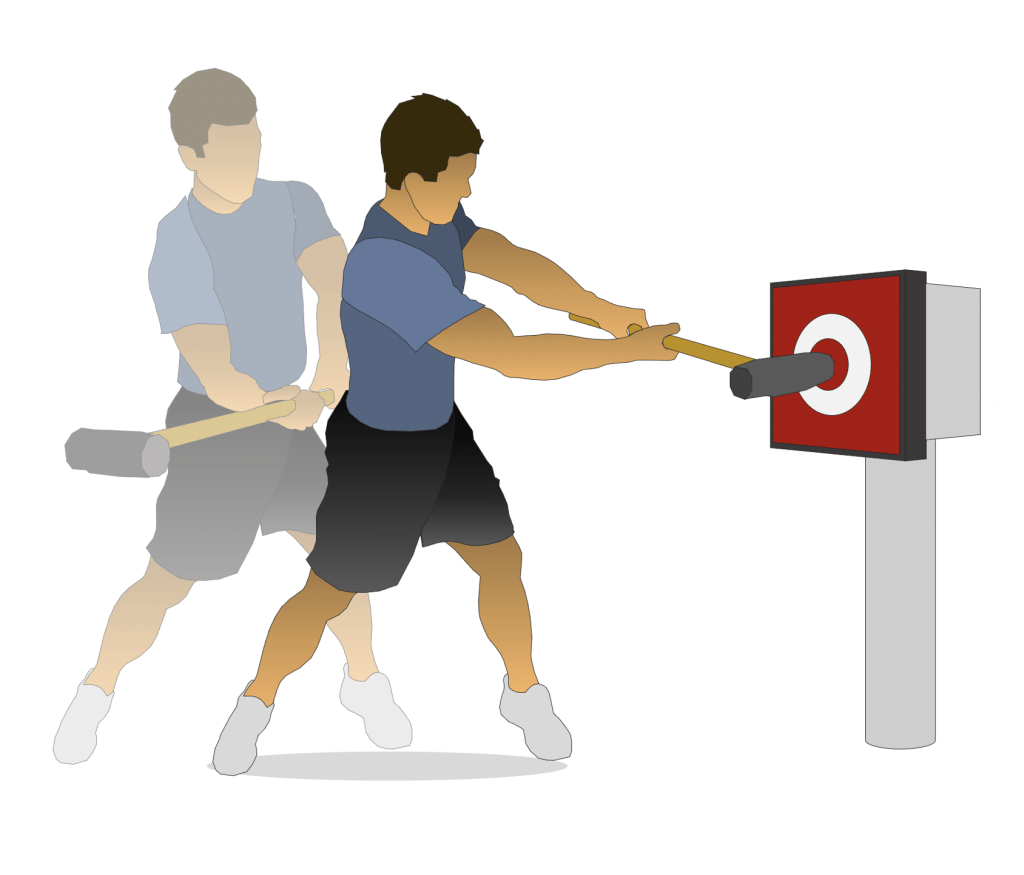
The Candidate Physical Ability Test is a rigorous assessment designed to evaluate aspiring firefighters’ physical fitness and capabilities. As an essential component of the firefighter selection process, the CPAT is a standardized measure to ensure candidates possess the strength, endurance, and skills required for the job’s demands.
Standardized Pass/Fail Test
Many city departments use the CPAT to assess a candidate’s ability to perform firefighter functions on the emergency scene (often called the “fire ground”).
The CPAT is a standardized test designed by the International Association of Fire Fighters (IAFF)6 and the International Association of Fire Chiefs (IAFC)7. It is not usually affiliated with or administered by the fire department.
Sequence of Events
Like the T-PAT, the CPAT is a sequence of events that requires the candidate to progress along a predetermined path from event to event in a continuous manner:
The difference between the two is how the events themselves are structured and the techniques used to perform them are executed. Even though they are similar, be aware of the differences.
Unlike the T-PAT, the CPAT is a standardized test that will not vary from state to city or city by city.
Standard CPAT events
The CPAT consists of eight distinct tasks, each simulating real-life firefighting scenarios. These tasks assess a candidate’s physical aptitude, mental resilience, and ability to perform under pressure. From stair climbing to equipment manipulation, candidates must navigate various challenges that mirror the physical demands they’ll encounter as firefighters.
- Stair Climb: Walk on a stair stepper for three minutes at 60 steps per minute with the addition of 25 pounds (75 extra total pounds). 25 pounds are removed after this event.
- Hose Drag: Dragging a charged hose line 100’ through a designated course to test upper body strength and endurance.
- Equipment Carry: Carrying various tools and equipment (usually two chain saws) 75’ to assess candidates’ ability to handle the weight and awkwardness of firefighting gear.
- Ladder Raise and Extension: Extending and raising a 24’ ladder to a designated height to evaluate upper body and core strength.
- Forcible Entry: Using a 9-pound sledgehammer to strike a waist-high target simulating the opening of a door or wall, assessing upper body strength and coordination.
- Search: Crawling through confined spaces to simulate searching for victims in low-visibility conditions.
- Rescue: Lift and drag, by shoulder straps, a 165-pound dummy for 70’ to safety to test overall strength and teamwork.
- Ceiling Breach and Pull: Striking a designated target to simulate breaching a ceiling during a fire or push/pull an overhead weight with a pike pole.
Common Attire and Challenges
- Throughout the events, candidates may be required to wear approved gear, including long pants, helmet, eye protection, firefighter work gloves, and footwear.
- Candidates usually wear a 50-pound weighted vest to simulate wearing a self-contained breathing apparatus (SCBA).
- Events are placed in a sequence that best simulates fire scene situations while allowing a recovery walk between events.
- No running is allowed between events.
The CPAT bypasses the costly expenses of administering the physical ability test, allowing departments to avoid liability and litigation by adopting this nationally recognized testing method.
Testing Site and Scoring the CPAT
Testing Sites
CPAT certifications can be attained by passing the test at a participating testing location. Check the internet for information that describes the details of testing in your area, and be sure to look for instructional videos, training plans, practice sessions, testing locations, and costs. CPAT certifications expire within one year. Your CPAT certification must be up to date on your hiring date.
Scoring the CPAT
The CPAT test is one in which the candidate will either pass or fail to pass the skills course within the required time limit. For example, it could be completing eight separate events in under 10 minutes and 20 seconds.
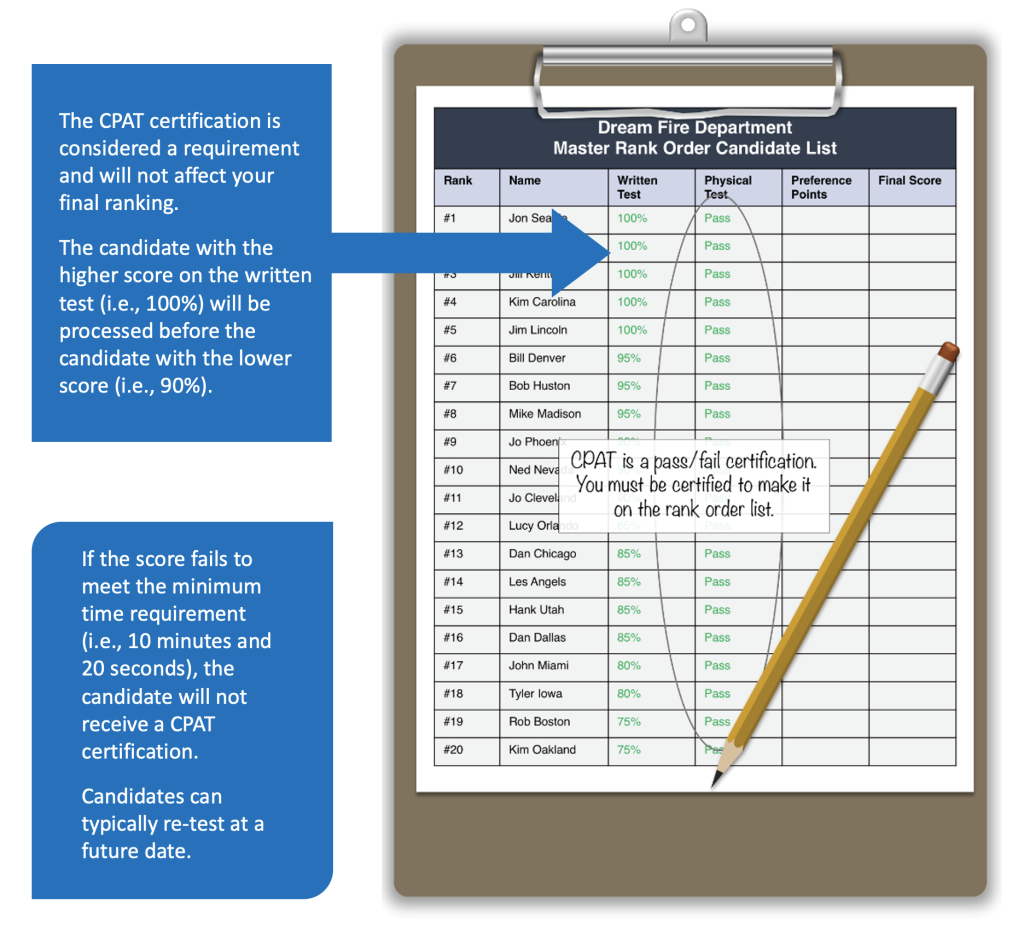
Effective Preparation for Success
If you dream of being a firefighter, you’ll need to get in shape by developing a fitness program with specific goals that align with the physical requirements of a firefighter. Having lung capacity, strength, and aerobic endurance aren’t developed overnight.
Elevating your performance in the competitive firefighter physical ability testing process or the CPAT requires a strategic and comprehensive approach. Here’s a roadmap to guide your preparation and ensure you’re ready to conquer the challenges.
Task-Specific Training
Tailor your training regimen to the tasks you’ll encounter in the competitive test. Devote focused sessions to practice hose hoists, ladder climbs, equipment carries, and other essential skills. You’ll build confidence and improve your overall performance by honing your technique and efficiency.
Cardiovascular Conditioning
The intense nature of the competitive test demands exceptional cardiovascular endurance. Incorporate high-intensity interval training (HIIT), running, cycling, or rowing to boost your stamina and ensure you’re prepared for the fast-paced nature of the challenges.
Strength and Power
Engage in strength training exercises that target the muscle groups crucial for firefighting tasks. Emphasize compound movements like deadlifts, squats, and overhead presses to build the core strength necessary for equipment manipulation and lifting.
Agility and Coordination
Enhance your agility through drills that mimic the quick movements required in firefighting scenarios. Cone drills, ladder drills, and obstacle courses can help improve your coordination and reaction times, enabling you to navigate challenges more effectively.
Mental Resilience
Prepare yourself mentally for the intensity of the competition. Train in challenging environments and conditions to simulate the stress of firefighting scenarios. Develop coping strategies to stay focused and composed under pressure.
Simulated Scenarios
Mimic the test conditions as closely as possible during your training. Practice wearing firefighting gear to acclimate to its weight and restrictions. Create realistic scenarios that require quick decision-making and adaptability.
Nutrition and Hydration
Fuel your body with the right nutrients to support your training. Prioritize lean proteins, complex carbohydrates, and sufficient hydration to ensure optimal energy levels and recovery.
Rest and Recovery
Adequate rest is essential for muscle recovery and overall performance. Incorporate rest days into your training plan to prevent burnout and injury.
Time Management
Focus on time management during your practice sessions. Aim to improve your speed and efficiency with each iteration of the tasks, preparing yourself to excel under time constraints during the competition.
Seek Professional Guidance
Consider working with a fitness coach or a firefighter training expert who can design a personalized program tailored to your strengths and areas of improvement.
By meticulously addressing these aspects in your training regimen, you’ll be primed to excel in the competitive firefighter physical testing process. Remember that preparation extends beyond physical prowess, encompassing mental fortitude, skill refinement, and a determined spirit. As you embrace the challenges and the opportunities for growth they offer, you’ll step into the competition with the confidence and readiness needed to shine as a true contender.
The 10,000-Hour Rule
Have you heard of the 10,000-hour rule? It’s an often-cited phrase that says it takes 10,000 hours of practice to become an expert or master performer in a given field.
While you may not have to work out 10,000 hours before your firefighter physical ability test, you should exercise regularly and customize your training to the test you’ll be taking. Doing so will undoubtedly improve your physical state and chances of doing well on the test.
Summary – The Firefighter Physical Ability Test
After the application phase opens, contact the city Department of Human Resources or hiring authority to determine which type of firefighter physical ability test they’ll administer. Request any known offerings that may be available to help applicants prepare for the exam.
- Everything you do should focus on improving your chances of passing the physical performance test and scoring highly. Run up the stairs at the office building instead of taking the elevator. Carry your bags on the golf course instead of using the cart.
- Design a foolproof training plan focusing on aerobic conditioning, strength development, and custom sprint workouts that mirror the components of each event you’ll be tested on.
Key Takeaways
- Find out what type of firefighter physical ability test you’ll be taking and the details of each event, then go to work preparing your body to crush it.
There is no easy way around it. Starting your exercise routine is a critical first step toward dominating the physical ability test, but it doesn’t need to be overwhelming.
Plan a strategy that fits your lifestyle, pace yourself, and develop a routine that may last your entire career. The more you work out, train, and practice, the better you will perform on the final physical test.

